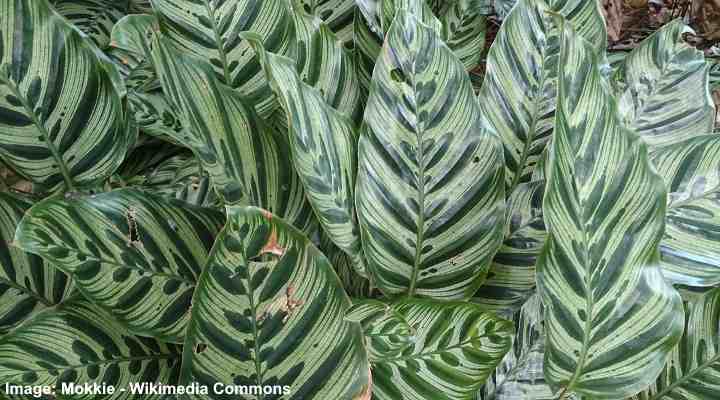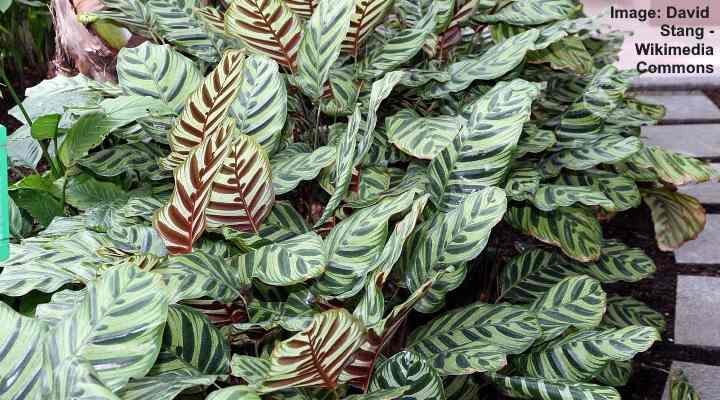Calathea Makoyana, sometimes known as the peacock plant, has glossy green oblong blotches on its broad, oval leaves. The calathea peacock leaves have pinkish-red undersides with similar patterned blotches on the underside. Calathea Makoyana is a low-maintenance plant that thrives indoors.
This is a thorough guide on how to care for Calathea makoyana. You’ll discover useful growing advice for handling common peacock plant care concerns at the conclusion of the article.
What is Peacock Plant (Calathea Makoyana)?

Peacock plants (Calathea makoyana) originate in South America and are cultivated indoors for their patterned foliage. In dappled light and wet conditions, the flowering foliage plant thrives on the forest floor. Calathea makoyana plants thrive in a temperature range of 70°F to 75°F (22°C to 24°C) in their natural habitat.
Indoor growth of Calathea makoyana is ideal. Thankfully, to grow this species as a houseplant, you don’t have to turn your home into a humid jungle. If you increase the humidity, the typical household temperature is ideal for potted Calathea plants. The decorative foliage of peacock plants makes them popular as houseplants.
The leaves of Calathea makoyana are rather large and pale green with black patterns. Green oblong formations with thin lines extending to the green margins are found in each leaf’s center green vein. The bottom sides of the peacock plant leaves have dark purple to red hues with corresponding patterns, similar to those on the top sides.
How to Care for a Calathea Makoyana – Overview
Grow peacock plants (Calathea makoyana) in bright indirect light, protected from direct sunlight, to care for them. When the soil is somewhat dry, peacock plants prefer a well-draining potting soil. Keep the humidity at least 60% and keep the peacock plants in typical room temperatures. During the growing season, fertilize monthly with a houseplant fertilizer.
Calathea Plants and Prayer Plants
Since they raise their leaves at night in a process known as nyctinasty, plants in the Calathea genus are sometimes referred to as prayer plants. Calathea plants’ leaves fold upright at the root of the stem, resembling that the plant is folding its leaves upward in prayer, in the evening.
Broad oval leaves with stunning variegation are found in plants from the Calathea and Maranta genera. The family Marantaceae includes both plant genera, which share similar features and care needs.
Facts About Calathea Peacock

Calathea makoyana grows indoors and can grow to be 2 feet (0.6 meters) tall, with lovely leaves that look like a lovely peacock’s tail. Because of its unusual leaf patterns, this Calathea species is sometimes referred to as “cathedral windows.” Shade plants with a slow to medium development rate, peacock plants are shaded.
Calathea peacock plants don’t grow taller than 2 feet (0.6 meters) indoors if they’re growing in pots. You don’t need to trim them because they naturally have a bushy growth habit, so they’ll grow faster.
Peacock Plant Flowers
When grown in the proper environments, Calathea makoyana plants create purple and white blossoms. Between the huge leafy leaves, the modest flowers bloom in tiny flower clusters. Peacock plants seldom bloom indoors. Their inflorescences, however, are dwarfed by the plant’s stunning patterned leaves.
Calathea Makoyana — Peacock Plant Care
Low-maintenance houseplants include Calathea makoyana plants. Easy-care plants need bright, moist soil that isn’t soggy, as well as plenty of humidity. Your peacock plant will continue to develop gorgeous leaves year after year if you get these three care aspects right. Let’s take a closer look at how to grow Calathea peacock plants at home.
Light Requirements for Growing Calathea Makoyana Indoors

To maintain peacock plants indoors, provide it with moderate indirect light and protect it from direct sunlight. The forest flower provides dappled light for Calathea species to grow. A east- or north-facing window will suit the Calathea houseplants best. To protect the plants from direct sunlight, keep them in other rooms behind a sheer curtain.
Peacock plants flourish faster in brighter light, despite growing well in shade or low-light situations. If the plants are kept in the dark for a long period of time, the leaf variegation may begin to fade. Move the plant pot to a brighter environment if its growth slows or the leaves lose their color.
The leaves of the peacock plant may be scorched by direct sunlight, resulting in browning at the tips. Moreover, too much sunlight tends to make the leaves paler, which you may notice. It is preferable to relocate the plant to a shadier area if you believe it is receiving too much sunlight. Peacock plants are excellent bathroom plants because they tolerate low light and need humidity.
The Best Soil for Calathea Peacock Houseplants
Grow peacock plants in a potting soil with excellent drainage and a little moisture. A combination of peat moss, compost, and perlite is the best potting soil for Calathea makoyana. To make Calathea soil, combine two parts peat moss, one part perlite, and one part compost.
This Calatheas potting substrate retains some moisture while allowing excess moisture to escape. Roots stay hydrated because peat moss is light and airy yet retains some moisture. To increase drainage, perlite is a great soil amendment. You may, however, create a well-draining potting soil by combining pumice, chicken grit, crushed gravel, or charcoal pieces.
Peacock plants’ health depends on having the right potting soil. If the soil becomes waterlogged, Calatheas are prone to root rot. To make sure your Calathea makoyana grows in the perfect soil conditions, here are a few tips:
- To improve drainage, add inorganic materials like perlite.
- Make sure there is at least one drainage hole on the bottom of the pot.
- To prevent your peacock plant from becoming rootbound, repot it every year or two.
- If the potting soil stops draining well, refresh it.
How to Water Peacock Plants

When the top layer of soil becomes dry, water Calathea makoyana houseplant. Make sure the top 1 inch (2.5 cm) of ground is dry before watering. thoroughly drench the soil with lukewarm water until it pours out the bottom when watering a Calathea plant. Before putting the peacock plant pot back on its saucer, allow all of the water to drain.
The soil of houseplants isn’t allowed to become too soggy thanks to the drench and dry watering method. To promote healthy growth, soaking the soil with water provides moisture to the roots. Soaking the earth prevents overwatering while also maintaining a moist, saturated growing medium.
watering on a schedule is one of the houseplant watering mistakes to avoid. Watering requirements vary depending on the type of plant. Furthermore, the speed with which the soil dries out is influenced by climate, season, kind of pot, and plant size.
In the winter, for example, you’ll want to water peacock plants less frequently than in the summer. Watering is the most common problem with Calathea makoyana care. The roots of the plant will rot, and the leaves will droop and yellow as a result of too much water. The peacock plant will wither if there isn’t enough water, and fungus gnats may appear.
Top peacock plant care tip: Rather of overwatering their peacock plants, it’s preferable to let them sink slightly.
Temperature Requirements for Growing Peacock Plants
Calathea makoyana, for example, thrives in indirect sunlight and enjoys average room temperatures. The optimum temperature for growing indoor peacock plants is 60 to 75 degrees Fahrenheit (16 to 24 degrees Celsius). Calathea peacock leaves start to curl if the room gets too hot. The Calathea plant will become droopy and begin to wilt when temperatures drop below 60 degrees Fahrenheit (16 degrees Celsius).
In the summer and winter, caring for Calathea plants indoors presents the most difficult challenge. Air-conditioning, heating, and chilly drafts may all stress the peacock plant if temperatures change too much. Keep your peacock plant away from hot radiators and cold air to ensure that it grows healthily all year.
Humidity Needs for Healthy Calathea Makoyana Growth

To thrive indoors, Calathea makoyana plants need humidity levels of above 60%. These tropical plants prefer to live in a humid environment, particularly in the winter. It’s essential to cultivating a healthy tropical Calathea if you want humidity levels to be correct.
Leaves stay green by keeping humidity above 60%. Increase humidity and encourage healthy peacock plant foliage using one or more of the following methods:
- To keep the big, oval green leaves moist, mist them daily.
- Set the peacock plant in a tray with water halfway full that has pebbles in it.
- To keep the leaves of a peacock plant moist, spray it with a lukewarm shower once a week.
- To create a more humid growing environment, Group Calatheas was added to other houseplants.
- To increase humidity in dry, heated rooms, use a humidifier.
How to Fertilize Calathea Peacock Houseplant
Every two to four weeks, give a Calathea makoyana a dose of fertilizer to encourage lush foliage. Dilute a strong nitrogen houseplant fertilizer to half strength. During the growing season, from spring to early fall, you should apply the fertilizer. When the plant stops growing during the fall and winter, don’t fertilize it.
Every two months, rinse the soil to prevent root burn from a buildup of fertilizer salts. Any excess minerals accumulated in the potting mix are flushed away for a few minutes after the soil has been watered. All you have to do is run lukewarm water through the soil for a few minutes in the peacock plant pot. Before replacing the pot in its original location, allow all of the water to drain.
Repotting a Calathea Peacock Plant

Every two years in the spring, repot your Calathea makoyana plants. Repotting is harmful to the majority of Calathea species, although they do not flourish if their roots are bound. Select a pot that’s one or two sizes larger than the one you have now when repotting. You can also check the health of the roots and regeneration of the potting soil while repotting.
Remove the peacock plant from its present container with care. Try to remove the roots without damaging them, and shake off any excess soil. Brown, mushy roots should be inspected and removed as needed. Half-fill the new pot with a suitable potting soil. Make sure the peacock plant is growing at the same height as it was previously in the pot. Fill in the remaining space with soil, and water thoroughly.
Pruning Calathea Peacock Plants
To eliminate dead or decaying leaves, Calathea makoyana plants simply require pruning. The rhizome root produces leaves that grow on a single stem. Cut the stems as short as possible to the ground when pruning a peacock plant. Finally, in the trash, throw away the old leaves. New growth should appear in its place after the dead leaves are removed.
Older leaves often fall to brown and die. Now, suppose you notice that many peacock plant leaves are brown. In this situation, you’ll need to look into the plant’s development conditions to identify the underlying problem.
How to Propagate Calathea Makoyana

Peacock plants may be propagated by root division, which is a simple procedure. You may divide the rhizome roots into two or three new plants when the Calathea makoyana plant is completely grown. Peacock plants should be repotted in the springtime for the best results.
Remove the plant from its packaging and remove any soil from the roots to propagate Calathea makoyana. ensuring that each section has a few stems and leaves. Divide the root into two or three sections. Keep the peacock plant moist and humid until you see new growth by placing it in a pot with loose potting soil.
Are Calathea Peacock Plants Toxic?
Cats and dogs are not at risk of becoming sick from Calathea makoyana plants. Plants from the Calathea genus are included on the ASPCA’s list of non-toxic houseplants.
Pests Affecting Calathea Makoyana Growth
Aphids, spider mites, and scale insects are common household pests that can harm peacock plants. To get rid of houseplant bugs, use a homemade neem oil solution. add 2 teaspoons of something to it 1 tsp. of neem oil is added to this recipe. 1 quart (1 l) of lukewarm water is used to make Castile soap. Spray the variegated foliage with the natural pesticide until it is well-doused in a spray bottle.
You’ll need to apply the plant pest control solution on a regular basis depending on how big the infestation is. Spray the neem oil insecticide onto the leaves once a week and leave it to dry for optimum effects.
Diseases Affecting Peacock Plant Growth
The most prevalent kind of sickness affecting Calathea makoyana is root rot caused by overwatering. Damage occurs before you notice it with root rot, making it difficult to fix. The likelihood is that the roots are rotting in soggy soil when leaves start to wilt, turn yellow, and become mushy.
Repotting your plant in new potting soil is the best way to preserve it. Always water peacock plants when the soil is partially dry to prevent root rot disease.
FAQ About Peacock Plant Care
There are a few indications that you must check the growing conditions even if Calathea makoyana plants are simple to care for indoors.
Why do Calathea Makoyana leaves curl?
Lack of water is usually indicated by leaf curling on a calathea plant, especially a calathea peacock. Check the soil for dryness if the plant leaves have curled. The Calathea makoyana’s potting soil should be thoroughly drenched before being allowed to drain if the potting mix is dry.
Why do my peacock plant’s leaves have brown tips?
Lack of humidity, excessive direct sunlight, or being in a draft are all common reasons for beautiful peacock plant leaves to develop brown tips. Try to figure out which of the possible causes for brown Calathea leaves is responsible for your treatment.
Why is my Calathea droopy?
Several care problems may be indicated by a Calathea with wilting leaves. Leaves will begin to droop if the temperature is too low or if there is a draft. Move the plant to a warmer area, away from drafts. But, severe root rot is indicated by limp stems that are mushy near the soil. To get rid of any dead roots and preserve your plant, you’ll have to act quickly in this scenario.
How do you revive a dying Calathea peacock plant?
The only way to avoid root rot in a dying peacock plant is to cut away any rotting, mushy roots. Unfortunately, it may be difficult to preserve your plant if the decay is significant.
